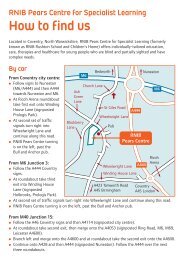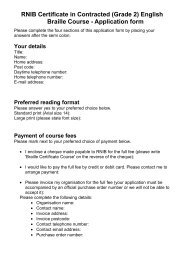The retail experience - RNIB
The retail experience - RNIB
The retail experience - RNIB
You also want an ePaper? Increase the reach of your titles
YUMPU automatically turns print PDFs into web optimized ePapers that Google loves.
Guiding basics for people with sight loss<br />
Guiding basics for people with sight loss<br />
If your offer of assistance is accepted, ask where the person wants to go and how they<br />
would like to be guided. Ask if they would like to take your arm and if there is room to<br />
walk side by side, stand next to them and let them take hold of your arm with their<br />
fingers in the crook of your elbow.<br />
You can keep your arm pointing downwards or you can bend it, as long as you keep<br />
your upper arm straight. By walking hand to arm in this way the person you are guiding<br />
will be at least half a pace behind you, making it easier to tell when you are turning by<br />
the movement of your body.<br />
Steps, stairs and slopes:<br />
l<br />
When you approach steps or a slope, tell the person you are guiding whether the<br />
steps go up or down. Wherever possible, they should be on the side with the<br />
handrail. If you need to change sides, inform the customer of your intention then ask<br />
them to stand still and let go of your guiding arm to allow you to come alongside.<br />
Walk towards the handrail and show its position with your guiding arm.<br />
l<br />
l<br />
l<br />
l<br />
As you begin to go up steps, the person you are guiding will feel your arm move<br />
when you place your weight on the first step. This is their cue to start. As you climb<br />
the second step, they are on the first. Tell them when you have reached the last step,<br />
stop and allow them to find it with their foot. When they feel their arm resume its<br />
normal position they will know that you are both on the level again.<br />
Going downstairs is always more difficult so give the person you are guiding plenty<br />
of time to hold onto the handrail securely and gauge the edge of the first step.<br />
Otherwise the technique is the same for going upstairs. Walk one step ahead, stop at<br />
the bottom and tell them there are no more steps.<br />
If you’re not as tall as the person you are guiding, arm movements are not so clearly<br />
felt, especially as they may have their hand on your shoulder. If you take your first<br />
step with the foot on the same side as your guiding arm, the movement is more<br />
obvious.<br />
If the person you are guiding has a guide dog, the dog may be a substitute for the<br />
handrail or they may prefer to use both handrail and dog, rejoining you at the bottom<br />
of the steps. Approach the person from the side opposite to the dog and do not take<br />
hold of the harness or lead, as the guide dog owner needs this to control the dog.<br />
Some people prefer to walk at your side without holding your arm. In some situations<br />
you can also walk in front and the dog will follow you.<br />
15

















